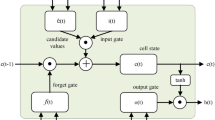The first experience in application of artificial neural networks to a study of the dynamic structure of a selected region of the near-Earth orbital space is described. An analysis of time series describing the evolution of the resonant characteristics of the dynamic structure of the region is usually performed manually. However, a study of the dynamic structure of a large region of the orbital space requires consideration of several tens of thousands of such time series. As an alternative approach, technologies of deep learning can be used, namely, design of architecture of one-dimensional convolutional neural network for supervised learning.
Similar content being viewed by others
References
A. G. Aleksandrova, T. V. Bordovitsyna, and I. V. Tomilova, Solar Syst. Res., 52, No. 5, 435–449 (2018).
A. G. Aleksandrova, T. V. Bordovitsyna, and I. V. Tomilova, Russ. Phys. J., 61, No. 4, 687–693 (2019).
A. G. Aleksandrova, T. V. Bordovitsyna, and V. B. Aleksandrov, Russ. Phys. J., 62, No. 3, 484–490 (2019).
C. M. Bishop, Pattern Recognition and Machine Learning, eBook, Springer (2006).
I. Goodfellow, Y. Bengio, and A. Courville, Deep Learning, eBook, The MIT Press (2016); URL: http://www.deeplearningbook.org/contents/TOC.html (06.12. 2019).
Description of the library Torch for Python; URL: https://github.com/pytorch/pytorch (06.12. 2019).
Description of the package nn of Torch Library for language Python; URL: https://pytorch.org/docs/stable/nn.html (12/6/2019).
J. VanderPlas, Python Data Science Handbook [Russian translation], Piter, Saint Petersburg (2018).
S. Raschka, Python and Machine Leaning [Russian translation], DMK Press, Moscow (2017).
A. G. Aleksandrova, T. V. Bordovitsyna, and I. N. Chuvashov, Russ. Phys. J., 60, No. 1, 80–89 (2017).
H. Ismail Fawaz, G. Forestier, J. Weber, et al., Data Min. Knowl. Disc., 33, No. 4, 917–963 (2019); https://doi.org/10.1007/s10618-019-00619-1.
M. T. Hagan, H. B. Demuth, M. Hudson Beale, and O. Jesús, Neural Network Design, eBook (2019); URL: https://hagan.okstate.edu/nnd.html (12/6/2019).
I. V. Tomilova, D. S. Krasavin, and T. V. Bordovitsyna, Astron. Vestn., 54, 2020 (in press).
Author information
Authors and Affiliations
Corresponding author
Additional information
Translated from Izvestiya Vysshikh Uchebnykh Zavedenii, Fizika, No. 3, pp. 70–75, March, 2020.
Rights and permissions
About this article
Cite this article
Krasavin, D.S., Aleksandrova, A.G. & Tomilova, I.V. Application of Artificial Neural Networks to an Analysis of the Dynamic Structure of the Near-Earth Orbital Space. Russ Phys J 63, 426–431 (2020). https://doi.org/10.1007/s11182-020-02053-z
Received:
Published:
Issue Date:
DOI: https://doi.org/10.1007/s11182-020-02053-z




